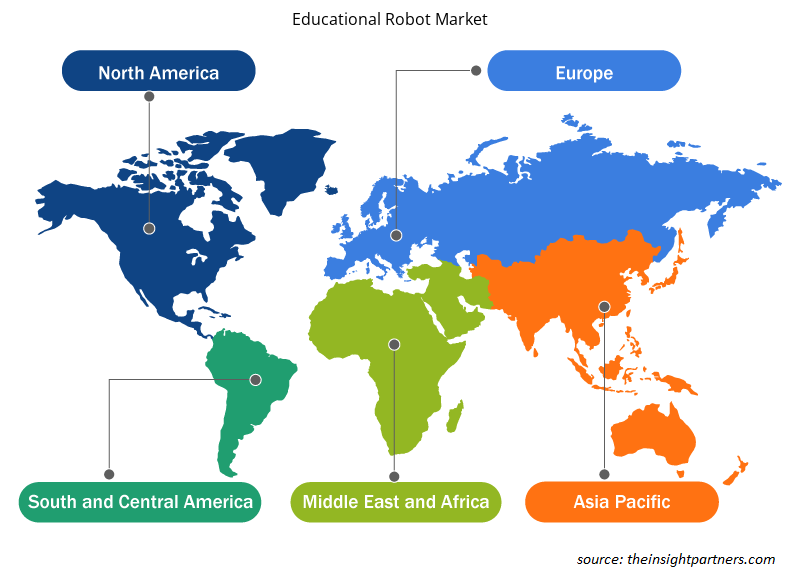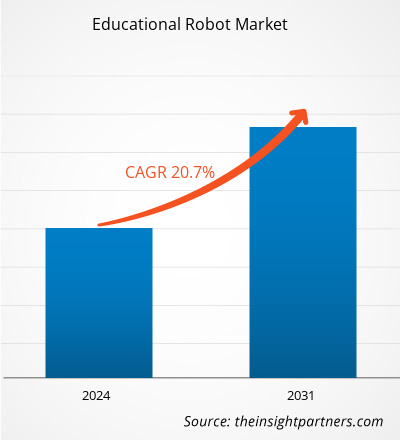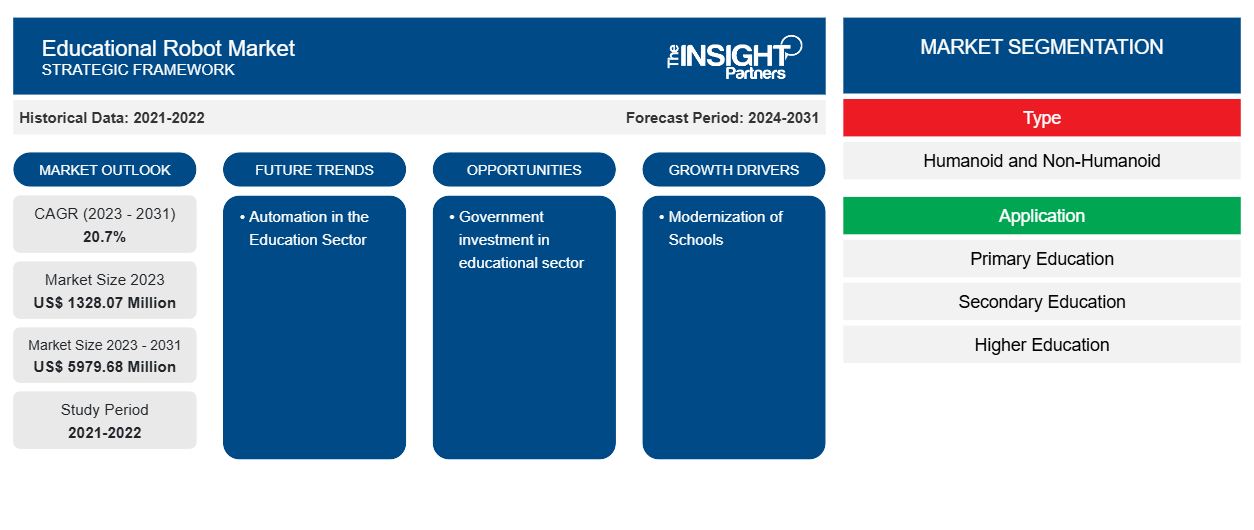Le marché des robots éducatifs devrait atteindre 5 979,68 millions de dollars américains d'ici 2031, contre 1 328,07 millions de dollars américains en 2023. Le marché devrait enregistrer un TCAC de 20,7 % au cours de la période 2023-2031. Les investissements publics dans la robotique et l'automatisation dans le secteur de l'éducation devraient rester des tendances clés du marché.CAGR of 20.7% during 2023–2031. The government investment in robotics and automation in the education sector are likely to remain key trends in the market.
Analyse du marché des robots éducatifs
L'accent croissant mis sur l'amélioration des sciences, de la technologie, de l'ingénierie et des mathématiques (STEM) stimule la croissance du marché. Les investissements des autorités gouvernementales dans le système éducatif favorisent encore davantage la croissance du marché. Les écoles et les collèges incluent divers aspects de la robotique, ce qui propulse la croissance du marché.
Aperçu du marché des robots éducatifs
Les robots éducatifs sont des robots programmables qui permettent aux élèves de tous âges d'approfondir leurs connaissances en robotique et en programmation. De plus, ils les aident à acquérir d'autres compétences cognitives. Ils fournissent aux élèves tout ce dont ils ont besoin pour construire et programmer un robot capable d'effectuer diverses tâches.
Personnalisez ce rapport en fonction de vos besoins
Vous bénéficierez d'une personnalisation gratuite de n'importe quel rapport, y compris de certaines parties de ce rapport, d'une analyse au niveau des pays, d'un pack de données Excel, ainsi que de superbes offres et réductions pour les start-ups et les universités.
-
Obtenez les principales tendances clés du marché de ce rapport.Cet échantillon GRATUIT comprendra une analyse de données, allant des tendances du marché aux estimations et prévisions.
Moteurs et opportunités du marché des robots éducatifs
Modernisation des écoles
Le gouvernement investit massivement dans le secteur de l'éducation pour moderniser les écoles et les collèges et améliorer encore l'apprentissage des étudiants. Ces investissements encouragent les acteurs du marché à fournir leurs robots éducatifs dans les écoles, ce qui stimule la croissance du marché. Par exemple, en avril 2022, la société danoise Shape Robotics a annoncé avoir signé un accord avec son homologue local KUBO Robots pour distribuer des robots éducatifs aux écoles de Roumanie.
L'automatisation dans le secteur de l'éducation
L'enquête mondiale 2023 d'ABB auprès de 2 301 professionnels de l'éducation a révélé que 80 % d'entre eux pensent que les robots et l'automatisation façonneront l'avenir de l'emploi au cours des dix prochaines années. L'utilisation de robots dans le système éducatif et les programmes d'enseignement. Les acteurs du marché des robots industriels se concentrent sur le lancement de robots dans le secteur de l'éducation qui peuvent alimenter le marché des robots éducatifs à l'avenir.
Analyse de segmentation du rapport sur le marché des robots éducatifs
Les segments clés qui ont contribué à l’élaboration de l’analyse du marché des robots éducatifs sont le type et l’application.
- En fonction du type, le marché des robots éducatifs est segmenté en humanoïdes et non humanoïdes. Le segment non humanoïde détenait la plus grande part du marché en 2023.
- En fonction des applications, le marché est segmenté en enseignement primaire, enseignement secondaire, enseignement supérieur et autres. L'autre segment détenait une part importante du marché en 2023.
Analyse des parts de marché des robots éducatifs par zone géographique
La portée géographique du rapport sur le marché des robots éducatifs est principalement divisée en cinq régions : Amérique du Nord, Asie-Pacifique, Europe, Moyen-Orient et Afrique, et Amérique du Sud et centrale.
La région Asie-Pacifique devrait connaître le TCAC le plus élevé au cours de la période de prévision. La région se concentre sur les progrès technologiques dans le secteur de l'éducation. L'augmentation des investissements dans le secteur de l'éducation complète la croissance du marché. L'introduction de robots dans les écoles stimule davantage la croissance du marché dans la région. Par exemple, en mars 2024, une école du Kerala a présenté le premier professeur d'IA du pays, Iris, pour faire un pas innovant vers l'éducation. Iris a été créée en partenariat avec Makerlabs Edutech et est le premier professeur de robot humanoïde de l'État et probablement du pays. Iris est capable de répondre à des questions complexes sur diverses matières, d'offrir un soutien vocal individualisé et de promouvoir des opportunités éducatives interactives. De plus, Iris est équipée de roues pour augmenter la mobilité.CAGR during the forecast period. The region is focused on technological advancement in the educational sector. The rising investment in the educational sector Kerala school introduced the country’s first AI Teacher, Iris to take an innovative step towards education. Iris was created in partnership with Makerlabs Edutech and is the state's and probably the nation's first humanoid robot teacher. Iris is capable of answering intricate queries across various subjects, offering individualized voice support, and promoting interactive educational opportunities. In addition, Iris is equipped with wheels to increase mobility.
Aperçu régional du marché des robots éducatifs
Les tendances régionales et les facteurs influençant le marché des robots éducatifs tout au long de la période de prévision ont été expliqués en détail par les analystes d’Insight Partners. Cette section traite également des segments et de la géographie du marché des robots éducatifs en Amérique du Nord, en Europe, en Asie-Pacifique, au Moyen-Orient et en Afrique, ainsi qu’en Amérique du Sud et en Amérique centrale.

- Obtenez les données régionales spécifiques au marché des robots éducatifs
Portée du rapport sur le marché des robots éducatifs
| Attribut de rapport | Détails |
|---|---|
| Taille du marché en 2023 | 1 328,07 millions de dollars américains |
| Taille du marché d'ici 2031 | 5 979,68 millions de dollars américains |
| Taux de croissance annuel composé mondial (2023-2031) | 20,7% |
| Données historiques | 2021-2022 |
| Période de prévision | 2024-2031 |
| Segments couverts |
Par type
|
| Régions et pays couverts |
Amérique du Nord
|
| Leaders du marché et profils d'entreprises clés |
|
Densité des acteurs du marché des robots éducatifs : comprendre son impact sur la dynamique commerciale
Le marché des robots éducatifs connaît une croissance rapide, tirée par la demande croissante des utilisateurs finaux en raison de facteurs tels que l'évolution des préférences des consommateurs, les avancées technologiques et une plus grande sensibilisation aux avantages du produit. À mesure que la demande augmente, les entreprises élargissent leurs offres, innovent pour répondre aux besoins des consommateurs et capitalisent sur les tendances émergentes, ce qui alimente davantage la croissance du marché.
La densité des acteurs du marché fait référence à la répartition des entreprises ou des sociétés opérant sur un marché ou un secteur particulier. Elle indique le nombre de concurrents (acteurs du marché) présents sur un marché donné par rapport à sa taille ou à sa valeur marchande totale.
Les principales entreprises opérant sur le marché des robots éducatifs sont :
- Aisoy Robotique
- Hanson Robotics Limitée
- Robotique modulaire
- PAL Robotique
- Société FANUC America
- Technologie d'innovation Sanbot Ltée
Avis de non-responsabilité : les sociétés répertoriées ci-dessus ne sont pas classées dans un ordre particulier.

- Obtenez un aperçu des principaux acteurs du marché des robots éducatifs
Actualités et développements récents du marché des robots éducatifs
Le marché des robots éducatifs est évalué en collectant des données qualitatives et quantitatives issues de recherches primaires et secondaires, qui comprennent d'importantes publications d'entreprises, des données d'associations et des bases de données. Quelques-uns des développements du marché des robots éducatifs sont énumérés ci-dessous :
- ABB Robotics a élargi son offre de formation avec le lancement de l'IRB 1090. Le robot éducatif industriel 1090, authentifié par l'institut d'éducation mondialement reconnu STEM.org, est conçu pour améliorer les compétences des étudiants et leur fournir un avantage concurrentiel dans la recherche d'un emploi. Le nouveau robot éducatif constitue un élément clé de l'offre de formation plus large d'ABB, qui comprend des robots industriels supplémentaires, ainsi que des packages éducatifs, des contrôleurs de nouvelle génération et des logiciels de programmation et de simulation leaders du marché. (Source : ABB Robotics, communiqué de presse, septembre 2023)
- MatataStudio, fournisseur de solutions d'apprentissage numérique axées sur l'innovation et l'originalité, a lancé un nouveau kit de robot éducatif appelé « VinciBot », visant à combiner l'informatique, l'intelligence artificielle et l'éducation de manière divertissante. Des concepts de haute technologie tels que l'IA et l'apprentissage automatique (ML) sont introduits dans les classes d'école primaire. Ces kits robotiques sont non seulement très éducatifs, mais intègrent également la programmation, la pensée informatique, la créativité et l'exploration. Le concept de conception de MatataStudio est d'encourager les enfants à maîtriser les connaissances de base de la programmation et de l'informatique en construisant et en utilisant des robots de leurs propres mains tout en cultivant leur pensée innovante et leurs capacités de résolution de problèmes. (Source : MatataStudio, communiqué de presse, février 2024)
Rapport sur le marché des robots éducatifs : couverture et livrables
Le rapport « Taille et prévisions du marché des robots éducatifs (2021-2031) » fournit une analyse détaillée du marché couvrant les domaines ci-dessous :
- Taille et prévisions du marché des robots éducatifs aux niveaux mondial, régional et national pour tous les segments de marché clés couverts par le périmètre
- Tendances du marché des robots éducatifs, ainsi que la dynamique du marché, comme les facteurs moteurs, les contraintes et les opportunités clés
- Analyse détaillée des cinq forces de PEST/Porter et SWOT
- Analyse du marché des robots éducatifs couvrant les principales tendances du marché, le cadre mondial et régional, les principaux acteurs, les réglementations et les développements récents du marché
- Analyse du paysage industriel et de la concurrence couvrant la concentration du marché, l'analyse de la carte thermique, les principaux acteurs et les développements récents sur le marché des robots éducatifs
- Profils d'entreprise détaillés
- Analyse historique (2 ans), année de base, prévision (7 ans) avec TCAC
- Analyse PEST et SWOT
- Taille du marché Valeur / Volume - Mondial, Régional, Pays
- Industrie et paysage concurrentiel
- Ensemble de données Excel
Rapports récents
Rapports connexes
Témoignages
Raison d'acheter
- Prise de décision éclairée
- Compréhension de la dynamique du marché
- Analyse concurrentielle
- Connaissances clients
- Prévisions de marché
- Atténuation des risques
- Planification stratégique
- Justification des investissements
- Identification des marchés émergents
- Amélioration des stratégies marketing
- Amélioration de l'efficacité opérationnelle
- Alignement sur les tendances réglementaires























 Obtenez un échantillon gratuit pour - Marché des robots éducatifs
Obtenez un échantillon gratuit pour - Marché des robots éducatifs